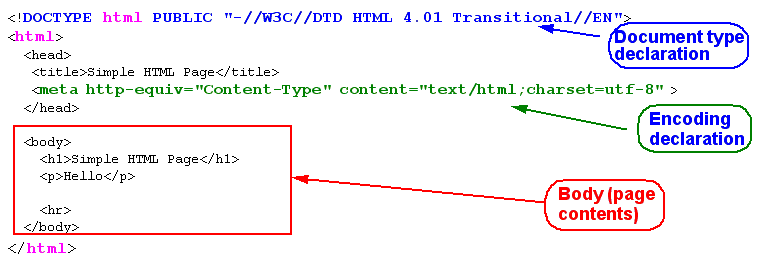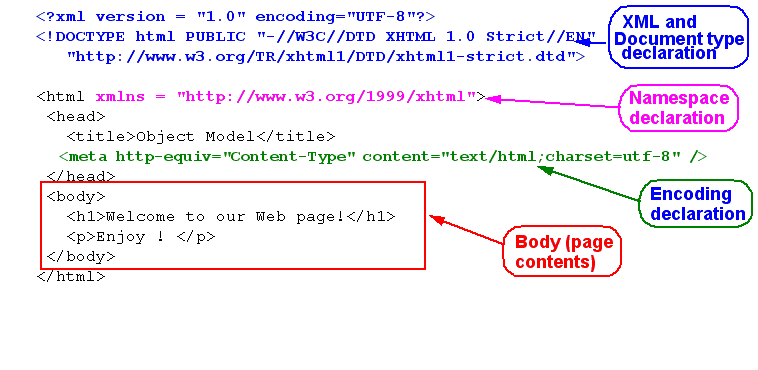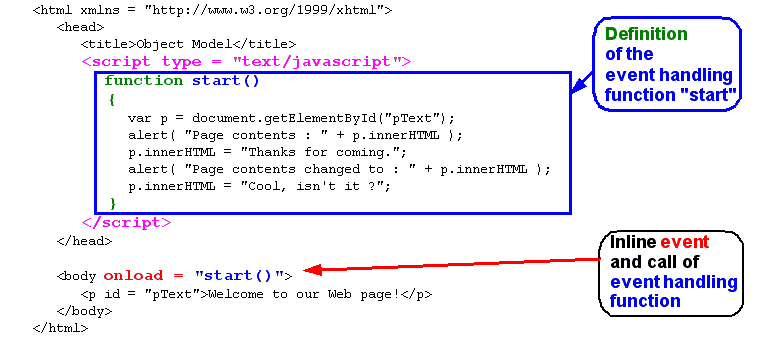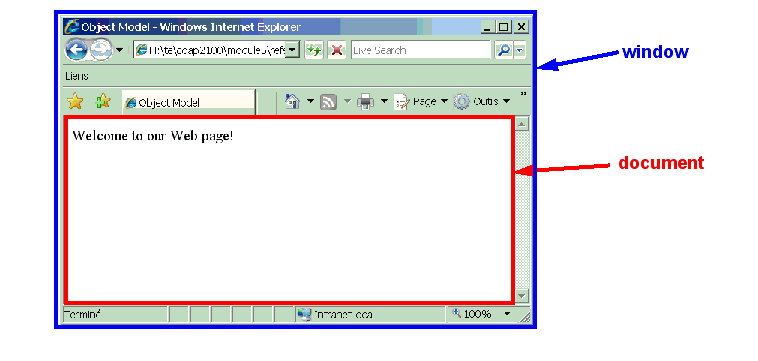DHTML
<pageby nominor="false" comments="false"/>
Dynamic HTML
Prerequisites
- Objectives
- Introduction to modern Dynamic HTML (DOM/CSS/JavaScript)
- Reuse of some simple JavaScript functions
- Object Referencing and modification of contents
- Dynamic Styles and Dynamic Positioning
- The concept of "tree walking"
- Disclaimer
- There may be typos (sorry) and mistakes (sorry again)
- Please also consult a recent manual or a textbook !
Acknowledgement
These slides have been prepared with the help of
- The Gecko DOM Reference and JavaScript reference
- http://developer.mozilla.org/en/docs/Gecko_DOM_Reference
- http://developer.mozilla.org/en/docs/JavaScript
- W3C specifications
- http://www.w3.org/TR/DOM-Level-2-Core/
- http://www.w3.org/TR/DOM-Level-2-HTML/
- http://www.w3.org/TR/DOM-Level-2-Events/
- http://www.w3.org/TR/DOM-Level-2-Style/
HTML and/or XHTML
- DOM works with all XHTML versions and all more recent HTML versions (> 4).
Example 1-1: HTML Page (preq-html-page.html)
<!DOCTYPE HTML PUBLIC "-//W3C//DTD HTML 4.01 Transitional//EN">
<html>
<head>
<title>Simple HTML Page</title>
<meta http-equiv="Content-Type" content="text/html;charset=utf-8" >
</head>
<body>
<h1>Simple HTML Page</h1>
<p>Hello</p>
<hr>
</body>
</html>
Notes:
- Navigators are very forgiving, you may omit the doctype, the encoding declarations, or even the head. But your page will not validate (which is not acceptable in most professional settings). Don't worry just for this class ...
Example 1-2: XHTML Page
- All most recent HTML versions are XHTML.
- XHTML is an XML application (i.e. it uses the XML formalism).
- XHTML is more powerful than HTML, but more strict and somewhat less forgiving ....
- All tags are lower case, all tags must be closed (think "boxes" within "boxes") !!!
1.2 CSS
- Style sheet = set of rules that describe how to render XML or (X)HTML elements
- Each rule has two parts:
- The selector : defines to which elements a rule applies
- The declaration : defines rendering, i.e. defines values for style properties
Example 1-3: A simple HTML example
H1 { color: red }
P { font-face: Verdana, sans-serif ; font-size: 12pt}
H1, H2, H3 { color : blue }
H1.ChapterTOC, H2.PeriodeTOC, H2.ExerciceTOC, H2.SectionTOC {
display: block;text-indent: 30pt;
text-align: left; font-size: 14.000000pt;
font-weight: Bold; font-family: "Times";
}
1.3 JavaScript
- JavaScript is a programming language that runs inside your navigator
- JavaScript functions are usually defined in the head and within " script " tags
- JavaScript functions can be called in various ways from the body of the document
- JavaScript instructions can be inserted within " script " tags (as in the head)
- JavaScript also can be found within "inline" event handler definitions
- Note: This is just a FYI-type of slide about JavaScript ....
Note on standardization
- The JavaScript language itself is fairly cross-browser compatible
- However, event handling and DOM is not fully standard (Microsoft DHTML is not a standard and even IE 7 is still quite far from implementing the DOM level 2.)
- Inline events management however is fairly cross-browser compatible
- More advanced stuff is less
Note on JavaScript and XHTML
- Valid XHTML requires JavaScript to be inserted within a commented CDATA section
<script language="javascript">
// <![CDATA[
alert ("hello I am alerting you from a valid XHTML Page");
// ]]>
</script>
- An other, better solution is to put the javascript code into an external file. E.g.
<script type="text/javascript" src="external.js" ></script>
2. Introduction
2.1 DHTML and DOM - some definitions
DHTML ?
- Dynamic HTML (DHTML) does not exist as a standard
- DHTML = HTML CSS Javascript Javascript DOM bindings
- So the difficult part is understanding DOM and JavaScript programming ...
DOM = Document Object Model
A document object model (DOM) is an application programming interface (API) for representing a document (such as an HTML document) and accessing and manipulating the various elements (such as HTML tags and strings of text) that make up that document.
- Allows Web authors to control and dynamically modify the presentation of their pages
- Gives them access to all the elements on their pages
- e.g. Headers, paragraphs, forms, styles
- All information is represented in an object hierarchy and from which scripts can retrieve and modify properties and attributes
- Non standard extensions give information about navigator and windows ...
A short history
- Only recently, DHTML became standardized as DOM Javascript.
- Before, DHTML was a nightmare for web developers, i.e. there was total incompatibility between browser brands and lesser incompatibilities between OS and navigator versions.
2.2 History of DOM and DOM levels
- DOM is defined by levels and several specifications per level
Level 0
- Non-standardized things, like Microsoft DHTML or Netscape DOM 4.x, etc.
- Methods that concern window and navigator are still being used and implemented in most browsers ...
Level 1 (octobre 1998)
- DOM Level 1 Core: defines how HTML and XML are represented in the machine and can be navigated
- DOM Level 1 HTML: HTML-specific extensions
Level 2 (2001)
- 6 specifications, adding XML namespace support, filtered views and events.
- DOM Level 2 Core Specification (extension of DOM Level 1 Core)
- DOM Level 2 Views Specification
- DOM Level 2 Events Specification: standardizes management of user generated events
- DOM Level 2 Style Specification: CSS
- DOM Level 2 Traversal and Range Specification
- DOM Level 2 HTML Specification: extensions for HTML
Level 3: contains 6 specifications
- DOM Level 3 Core
- DOM Level 3 Load and Save
- DOM Level 3 XPath
- DOM Level 3 Views and Formatting
- DOM Level 3 Requirements
- DOM Level 3 Validation
Other W3C languages that define DOM extensions
- MathML
- SVG
- SMIL
Non W3C languages also may support DOM
- X3D, ....
2.3 Implementations
- Most modern browsers (2005 ) implement most of DOM level 1 specs.
- Most modern browsers implement at least some of DOM level 2.
- Some proprietary DOM 0 still is needed (e.g. navigator information). These are usually cross-browser compatible.
- Other "old style" DHTML should be avoided if possible (e.g. "innnerHTML")
- Other "old style" DHTML should be avoided in every case (e.g. the MS DHTML model).
- Comparison of layout engines (DOM) (wikipedia)
- http://www.quirksmode.org/dom/w3c_html.html (Quirksmode)
- http://www.quirksmode.org/dom/w3c_core.html
Executive summary regarding DOM/DHTML variants:
- Plan for the future (use standards whenever possible)
- Make sure to test your code with browsers your target population will use
2.4 DOM objects Overview
There are a few system variables that point to objects which allow you to access the current document, the current window and the navigator. The most important ones are:
- document : to access and manipulate contents of a page
- window : to access information about the window and to create new windows
- navigator : to access information about the navigator (browser).
3. Referencing and changing objects
The principle
In order to do some DHTML your script must be able to refer to HTML elements and then change something. So you need to know 4 things:
- how to refer to a specific object within a page (also called "document")
- how to change the contents of an HTML element
- how to define a JavaScript (JS) function that will do this.
- how to launch (call) this JS function
Summary of the most simple solution:
- Add id="....." attributes to you HTML elements you later want to use
- Launch the JavaScript function when the page will load
<body onload = "start() ">
means "when the page loads into the browser, launch the start() function
- Write a little function that does the following
- Use the document.getElementById("your_id") method to refer to an object and use the innerHTML method to change contents of an objects
var my_para = document.getElementById( "p1 ");
means: find the HTML with id=p1 in the page and put this object in the my_para variable
alert( "Paragraph contents : " my_para.innerHTML );
means: create a little popup window that will display the "inside" of the referenced HTML element.
Example 3-1: Simple object referencing
- reference0.html
<?xml version = "1.0"?>
<!DOCTYPE html PUBLIC "-//W3C//DTD XHTML 1.0 Strict//EN"
"http://www.w3.org/TR/xhtml1/DTD/xhtml1-strict.dtd">
Â
<html xmlns = "http://www.w3.org/1999/xhtml">
<head>
<title>Object Model</title>
Â
<script type = "text/javascript">
// Definition of a start function
function start ()
{
var my_para = document.getElementById( "p1 ");
alert( "Paragraph contents : " my_para.innerHTML );
} // end of start function
</script>
Â
</head>
Â
<body onload = "start() ">
<p id = "p1"> Welcome to our Web page!</p>
</body>
</html>
Â
Example 3-2: Simple object referencing and change
- reference.html
- This example shows how to change the contents of an HTML element
- Once we have a reference to the HTML element ("para") in this case we can change it
<?xml version = "1.0"?>
<!DOCTYPE html PUBLIC "-//W3C//DTD XHTML 1.0 Strict//EN"
"http://www.w3.org/TR/xhtml1/DTD/xhtml1-strict.dtd">
Â
<html xmlns = "http://www.w3.org/1999/xhtml">
<head><title>Object Model</title>
<script type = "text/javascript">
function start()
{
var para = document.getElementById("pText");
alert( "Page contents : " para.innerHTML );
para.innerHTML = "Thanks for coming.";
alert( "Page contents changed to : " para.innerHTML );
para.innerHTML = "Cool, isn't it ?";
}
</script>
</head>
<body onload = "start()">
<p id = "pText">Welcome to our Web page!</p>
</body>
</html>
4. Style
- Warning (!!!) "CSS inside the DOM" has slightly different names than CSS properties
- For a list see e.g.
- http://developer.mozilla.org/en/docs/DOM:CSS
- http://www.w3.org/TR/DOM-Level-2-Style/css.html#CSS-CSS2Properties
- But most of the time it's easy to guess the DOM name:
- remove the "-"
- capitalize words (except the first one)
- example: CSS property "background-color" becomes DOM/CSS "backgroundColor".
- Some examples:
|
DOM CSS |
CSS property |
|---|---|
|
background |
background |
|
backgroundColor |
background-color |
|
borderColor |
border-color |
|
fontFamily |
font-family |
|
fontSize |
font-size |
|
marginBottom |
margin-bottom |
|
marginLeft |
margin-left |
- In order to change a style property of an element, use the syntax:
object.style.xxx = "yyy";
e.g.
para.style.fontFamily="Helvetica"
Example 4-1: Changing style of background with a prompt
- dynamicstyle.html
<html xmlns = "http://www.w3.org/1999/xhtml">
<head>
<title>Object Model</title>
Â
<script type = "text/javascript">
<!--
function start()
{
var inputColor = prompt(
"Enter a color name for the "
"background of this page", "" );
document.body.style.backgroundColor = inputColor ;
}
// -->
</script>
</head>
Â
<body onload = "start()">
<p>Welcome to our Web site!</p>
</body>
</html>
Example 4-2: Change style with a push button
- change_style1.html
<script type="text/javascript">
function changeText()
{
var p = document.getElementById("pid");
p.style.color = "blue"
p.style.fontSize = "18pt"
}
</script>
.....
<p id="pid"
onclick="window.location.href = 'http://www.cnn.com/';">News Link</p>
<form>
<p>
<input value="Change style" type="button" onclick="changeText();">
</p>
</form>
Example 4-3: Change style forth and back with a push button
- change_style2.html
(code not shown here, look at the file please)
- The Window interface gives information about the window
- It also includes a reference to the navigator
- (Based on the AbstractView interface of DOM Level 2 Views Specification)
A few examples
window.document
- gives the document object of a window (useful if you manipulate more than one window)
doc= window.document;
// print the title
window.dump(doc.title);
- gives the navigator object
nav = window.navigator;
- you then can extract information from the navigator, e.g.
alert ("Language of your browser: " nav.language);
- Navigator information is important for writing hairy cross-browser scripts. Here are a few properties of interest (there are more):
navigator.appName
navigator.appVersion
navigator.userAgent
navigator.appCodeName
- On the Web, you can find good browser detection scripts, e.g.
- http://www.webreference.com/tools/browser/javascript.html
window.history
h = window.history;
alert ("You have " h.items " item in your navigation history");
window.status
- can read or change the "status bar" (at bottom of window)
window.status = "cool website";
- E.g. following code shows how to trigger status bar change when user moves the mouse over a link (by default most browsers will not allow this).
<a href="http://yoursite.org/"> onmouseover="status='Consult this'; return true;">Your site</a>
window.print()
- Sends content of window to printer
window.print();
- navigator-props.html
<html xmlns = "http://www.w3.org/1999/xhtml">
<head>
<title>The navigator Object</title>
<script type = "text/javascript">
<![CDATA[
function start () {
var output1 = "Hello, your " navigator.appName " navigator has the following properties <br/>";
document.writeln(output1);
var output2 = "<ul>";
output2 = "<li>Navigator Application Name: " navigator.appName "</li>";
output2 = "<li>Version = " navigator.appVersion "</li>";
output2 = "<li>User agent = " navigator.userAgent "</li>";
output2 = "<li>Code Name = " navigator.appCodeName "</li>";
output2 = "</ul>";
document.writeln(output2);
if (navigator.javaEnabled()) document.write("<li>Java works (enabled)");
else document.write("<li>Java doesn't work");
}
]]>
</script>
</head>
<body onload = "start()"> </body>
</html>
- File: navigator.html (this script is a bit too simple for real world use)
<html xmlns = "http://www.w3.org/1999/xhtml">
<head>
<title>The navigator Object</title>
<script type = "text/javascript">
function start() {
alert ("Your Navigator is " navigator.appName
", Version "
navigator.appVersion.substring() );
if ( navigator.appName == "Microsoft Internet Explorer
" ) {
if ( navigator.appVersion.substring( 1, 0 ) >= "4" )
document.location = "newIEversion.html";
else document.location = "oldIEversion.html";
}
else
document.location = "NSversion.html";
}
</script>
</head>
<body onload = "start()">
<p>Redirecting your browser to the appropriate page,
please wait...</p>
</body> </html>
(rather use a professional script like this)
6. Collections and creation of elements
- To understand coode in this chapter you need some training in programming (which we don't provide here)
- Therefore, just try to grasp some very abstract principles given in class and try to copy/paste some code with only very minor modifications ....
6.1 Collections
- Instead of dealing with just one single object, you may want to write a script that can deal with several objects at the same time. E.g:
- all objects that have the same "name" attribute (only few HTML elements can have a name attribute)
- all elements of list
- all titles (h2) of a page
Example 6-1: Emphasize child elements
- This code will hightlight contents of li elements within an ol or ul HTML element that has id="important"
- emphasize-collection.html
<html xmlns = "http://www.w3.org/1999/xhtml">
<head>
<title>Collections</title>
Â
<script type = "text/javascript">
function doit()
{
var list = document.getElementById("important");
var list_els = list.getElementsByTagName("li")
;
// deal with each of the subelements
for (var i = 0; i < list_els.length; i ) {
// if (list_els[i].nodeType == 1)
list_els[i].style.color = "red";
}
}
</script>
</head>
<body>
<form>
<p><input value="Highlight important things" type="button" onclick="doit(); ">
</p>
</form>
Â
<p>Welcome to our <strong>Web</strong> page!</p>
<div></div>
<p>Here we have list of important things:</p>
<ul id="important">
<li>This is important</li>
<li>This is quite important</li>
<li>This is also important</li>
</ul>
<p>Here we have list of less important things:</p>
<ul>
<li>This is less important</li>
<li>This is not so important</li>
<li>This ain't important either</li>
</ul>
</body>
</html>
6.2 Tree walking
- Tree walking means to look at an element (for starters) and then examine its children, the children of children etc.
- We start using "real" algorithms here which are not easy to understand. However, you may take this code and just change a few things in order to fit it to your purpose. Make sure to change only 1-2 things
- We also introduce here the concept of functions that take arguments . Basically, we can call a function and give it information it has to deal with.
[dyn-html.html#0_79242 exemple Tree walking: Collect element names]
- This is fairly uninteresting code since it will only display HTML elements used in a document. Just copy/paste all the javascript code and the input button if you want to see it in action in one of your pages.
[dyn-html.html#0_39913 exemple Tree walking: Change color style]
- Copy the whole script section in the head plus the lines with the input buttons. Just view the source of the html page (tree-walking2.html). It's all in there for you to grab ...
- Decide which elements in your HTML text you wish to highlight and add a class attribute to each of these, e.g. something like:
<p class="important" >
- Change the class attribute value from "important" to whatever you wish, but don't forget to change the argument when calling the do_document function, e.g. if the CSS class you wish to highlight is " cool ":
<input type=button onClick="do_document('cool
','red
');" value="Highlight">
- You may add as many input buttons you like, but of course there should be a corresponding css class and a color .
Example 6-2: Tree walking: Collect element names
- tree-walking.html
var node_list = "";
function do_document
() {
// call the mark_tags function with argument "body of the document"
mark_tags (document.body );
alert ("This text has the following elements: " node_list);
}
Â
function mark_tags
(node
) {
// Check if n is an Element Node
if (node.nodeType == 1 /*Node.ELEMENT_NODE*/) {
// Append the node name to the list
node_list = node.nodeName " ";
// Let's see if there are children
if (node.hasChildNodes()) {
// Now get all children of n
var children = node.childNodes;
// Loop through the children
for(var i=0; i < children.length; i ) {
mark_tags(children[i]); // Recurse on each one
} } } }
</script>
</head><body>
<h1>Tree walking</h1>
<input type=button onClick="do_document() ;" value="Show body node names">
Example 6-3: Tree walking: Change color style
- tree-walking2.html
<script>
Â
function do_document (css_class,color) {
mark_tags(document.body,css_class,color);
}
Â
function mark_tags(node,css_class
,color
) {
// Check if n is an Element Node
if (node.nodeType == 1 /*Node.ELEMENT_NODE*/) {
// Highlight if needed
if (node.getAttribute("class") == css_class)
node.style.color = color;
// Let's see if there are children
if (node.hasChildNodes()) {
// Now get all children of node
var children = node.childNodes;
// Loop through the children
for(var i=0; i < children.length; i ) {
// Recurse on each child
mark_tags(children[i],css_class,color);
} }}
}
</script>
</head>
Â
<body>
<h1>Tree walking</h1>
<input type=button onClick="do_document('important
','red
');"
value="Highlight important stuff">
<input type=button onClick="do_document('boring
','grey
');"
value="Highlight boring stuff">
.....
<p class="boring ">Let's hope you enjoy this</p>
<p class="important ">If you want to reuse this code:</p>
.....
Â
Example 6-4: Tree walking: Change any style
- tree-walking3.html
- Students who wish to change other style properties may look at this code ...
- Implementation of a do_document(css_class,style_value,style_property) function.
- E.g.
do_document('boring','none','display')
would change the display property of elements with class="boring" to none (hide elements)
6.3 Creation of elements
- Creation of new HTML elements is somewhat hairy (unless you use the innerHTML method which is less standard and doesn't give you the same power)
- You have to create an element with the document.createElement "factory" method.
- Then you have to fill in the element, e.g. by creating a TextNode with document.createTextNode
- Then only you can insert it, e.g. append an element's children with heading.appendChild();
Example 6-5: Simple append example
- insert3.html
<script type="text/JavaScript">
function insert_things () {
// heading will contain a new "h1" element (node)
heading = document.createElement
("h1");
// heading_text will contain a new "text" node
heading_text = document.createTextNode
("I love pressing buttons !");
// we can now ask the heading node to insert the heading_text
heading.appendChild(heading_text);
// Finally we can ask the body to insert this at the end.
document.body.appendChild(heading);
}
</script></head>
<body>
<input type=button onClick="insert_things();" value="DoIt">
7. Animation
- Animation means changing some style properties (e.g. position, size, color)
- There are several sorts of animations, e.g.
- automatic animations
- animations that react to user input
- Warning (again). This section requires some programming skills. If you don't have these, do not worry. The goal here is to demo that more sophisticated animation can be done with a little bit of scripting. Learning how to script takes several weeks ....
Example 7-1: User-driven object moving
- move-object1.html
- In the body, we use href attributes to call a moveitBy javascript function
- This function is called with 3 arguments: id , move_right , move_down
- "id" is the value of and id attribute
- move_right and move_down are positive or negative numbers (pixels to shift).
Â
<div id="image" style="position: relative; left: 0px; top: 0px;">
<img src="tecfa-affiche.gif" alt="logo">
</div>
<ul>
<li><a href="javascript:moveitBy('image',20,0)
;">Move by 20px (right)</a></li>
<li><a href="javascript:moveitBy('image',-20,0)
;">Move by 20px (left)</a></li>
- The moveitBy function
- firstly takes the first argument (an id) and retrieves the div object within which we placed the image
- it then modifies "left" and "top" values of this div by adding or substracting 20.
function moveitBy
(img, x, y){
var obj = document.getElementById(img);
obj.style.left = parseInt(obj.style.left) x "px"
obj.style.top = parseInt(obj.style.top) y "px"
}
- The function moevitTo will reposition an object at given left/top coordinates
function moveitTo(img, x, y){
var obj = document.getElementById(img);
obj.style.left = x "px"
obj.style.top = y "px"
}
</script>
Example 7-2: Automatic font, size and position animation
- dynamicposition.html
- also requires some programming skills to understand ....
<?xml version = "1.0"?>
<!DOCTYPE html PUBLIC "-//W3C//DTD XHTML 1.0 Strict//EN"
"http://www.w3.org/TR/xhtml1/DTD/xhtml1-strict.dtd">
Â
<!-- Dynamic Positioning, originally from Deitel -->
<!-- adapted to more real DOM less difficult code by Daniel K. Schneider -->
Â
<html xmlns = "http://www.w3.org/1999/xhtml">
<head>
<title>Dynamic Positioning</title>
Â
<script type = "text/javascript">
var speed = -5;
var count = 10;
var firstLine = "Text growing";
var pText;
Â
function start() {
pText = document.getElementById("pText");
window.setInterval( "run()", 100 );
}
Â
function run() {
count = speed;
Â
if ( ( count % 200 ) == 0 ) {
speed *= -1;
pText.style.color = ( speed < 0 ) ? "red" : "blue" ;
firstLine = ( speed < 0 ) ? "Text shrinking" : "Text growing";
}
Â
size = count / 3 ;
pText.style.fontSize = size "px";
pText.style.left = count "px";
pText.innerHTML = firstLine "<br /> Font size: " count "px";
}
// -->
</script>
</head>
Â
<body onload = "start()">
<p id = "pText" style = "position:absolute; left:0; font-family:serif; color:blue">
Welcome!</p>
</body>
</html>
Exercise
- Create an HTML page that includes some elements (tags) some of which you consider important.
- Add a class attribute to these with some value, e.g.
<ul class="important"> <li>Before you start, insert the key</li> </ul>
- Implement at least one push button that will change styling of these elements
- Optional: Implement other push buttons that highlight other elements
- Look at [dyn-html.html#0_39913 exemple Tree walking: Change color style]
- For those with some programming skills:
- Change other style elements, e.g. make elements visible or hidden, change position, etc.
- Look at [dyn-html.html#0_79725 exemple Tree walking: Change any style]




